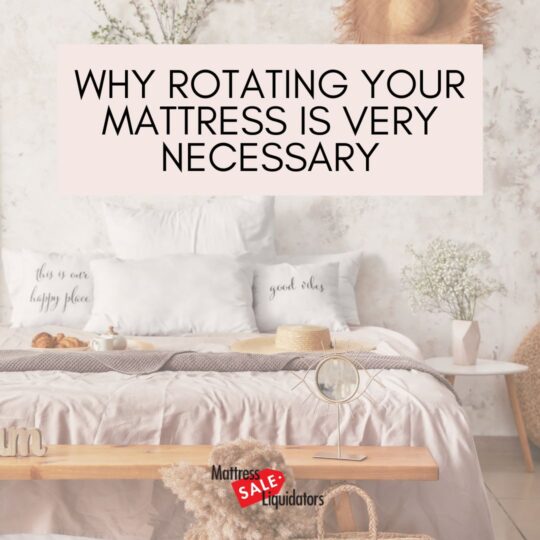Rotating your mattress periodically is a simple yet essential maintenance practice that can significantly extend its lifespan and enhance overall sleep quality. Regardless of their type or material, mattresses undergo wear and tear over certain periods due to continuous use. Regularly rotating your San Diego mattress helps distribute the wear more evenly, preventing sagging, indentations, and other issues that can negatively impact comfort and support. Here are several reasons from a mattress store expert in San Diego, Mattress Sale Liquidators, why rotating your mattress is a recommended practice:

Even Wear and Tear
Individual sleeping habits often result in specific areas of a mattress bearing more weight or pressure. Consistent rotation ensures even wear across the entire surface, preventing premature deterioration and preserving the structural integrity of your mattress in San Diego.
Sagging Prevention
Mattresses can develop sagging or indentations over time, particularly in areas where the body exerts consistent pressure. Regularly rotating the mattress prevents these impressions from becoming permanent, maintaining an even sleep surface and ensuring optimal support for your San Diego mattress.
Extended Lifespan
Rotating your mattress can significantly extend its lifespan by minimizing uneven wear and preventing sagging. A well-maintained mattress is more likely to provide comfort and support for longer, saving you money in the long run by delaying the need for a replacement.
Enhanced Comfort
A mattress that has been regularly rotated maintains its original level of comfort. Even wear and support contribute to a more comfortable sleep surface, ensuring you enjoy a restful night’s sleep.
Reduced Pressure Points
Rotating the mattress helps reduce the formation of pressure points, which can be causation for discomfort and pain. By varying the areas of the mattress that support the body, you can minimize the risk of waking up with sore muscles or joints.
Improved Sleep Quality
A well-maintained mattress directly correlates with improved sleep quality. Even support and reduced pressure points contribute to a more restful and rejuvenating sleep experience, letting you wake up feeling refreshed.
Prevention of Mold and Mildew
Moisture can accumulate in mattresses over time, leading to the growth of mold and mildew. Rotating the mattress allows both sides to receive adequate ventilation, minimizing the risk of moisture buildup and creating a healthier sleep environment.
Alignment Maintenance
For mattresses that are not symmetrical, such as those with specific comfort layers or targeted support zones, rotating helps maintain proper alignment. This is especially important for mattresses with distinct top and bottom layers to ensure the intended support features remain effective.
Adaptation to Changing Sleep Patterns
Over the years, sleep preferences and habits may change. Rotating the mattress provides an opportunity to assess if the current sleep surface still meets your needs or if adjustments, such as adding a mattress topper, are necessary for continued comfort.
Warranty Compliance
Many mattress warranties stipulate that regular rotation is a requirement to maintain coverage. Failing to adhere to these guidelines may void the warranty, emphasizing the importance of this simple maintenance practice.
Conclusion
In conclusion, the regular rotation of your mattress is a practical and proactive measure for even wear, sagging prevention, and an extended overall lifespan. This routine maintenance contributes to enhanced comfort, improved sleep quality, and a healthier sleep environment. Consider checking the manufacturer’s recommendations for your specific mattress type and following their rotation frequency and method guidelines. Explore the diverse options at Mattress Sale Liquidators, the choice mattress store in San Diego, to find quality mattresses that align with your needs.
Essential Guide In Rotating Your Mattress Effectively
Determine the Type of Mattress
Before starting the rotation process, identify the type of San Diego mattress you have. Different mattress materials may require different rotation techniques. For instance, traditional innerspring mattresses benefit from complete rotations, while memory foam mattresses may only need to be rotated from head to foot.
Establish a Rotation Schedule
Create a rotation schedule based on the recommendations provided by the mattress manufacturer. Generally, it’s advisable to rotate your mattress in San Diego every three to six months to ensure even wear. However, heavier individuals or those who spend significant time in bed may need to rotate more frequently, perhaps every two to three months.
Prepare the Mattress
Before rotating the mattress, remove all bedding, including sheets, blankets, and mattress protectors. Clear the surrounding area to provide ample space for maneuvering the mattress.
Rotate the Mattress
Depending on the type of mattress you have, choose the appropriate rotation method:
- Full Rotation (Innerspring Mattresses): If you have a traditional innerspring mattress, rotate 180 degrees so the head end becomes the foot end. This ensures that different sections of the mattress receive equal pressure over time.
- Head-to-Foot Rotation (Memory Foam Mattresses): For memory foam mattresses or models with specific comfort layers, rotate the mattress from head to foot. This involves flipping the mattress so that the head end becomes the foot end while maintaining the same orientation.
Enlist Help if Needed
Mattresses can be heavy enough to rotate in significantly larger sizes like queen or king. If you have difficulty handling the mattress on your own, consider enlisting the much-needed help of a friend or family member to assist with the rotation process.
Secure the Mattress
Once the mattress is rotated, ensure it is properly positioned and centered on the bed frame or foundation. Make any necessary adjustments to ensure a snug fit.
Reapply Bedding
After rotating the mattress, reapply your bedding, including sheets, blankets, and mattress protectors. Ensure the bedding is smooth and wrinkle-free to maximize comfort and support.
Keep a Rotation Record
Maintain a rotation record to track when you last rotated your mattress and when the next rotation is due. This will help you stay consistent with your rotation schedule and ensure that your mattress receives proper care and maintenance over time.
Conclusion
Following these basic steps, you can effectively rotate your mattress in San Diego to promote even wear and extend longevity. Consistent rotation and proper mattress care and maintenance can help you enjoy a comfortable and supportive sleeping surface for years.

